fog light INFINITI QX50 2020 User Guide
[x] Cancel search | Manufacturer: INFINITI, Model Year: 2020, Model line: QX50, Model: INFINITI QX50 2020Pages: 572, PDF Size: 7.29 MB
Page 244 of 572
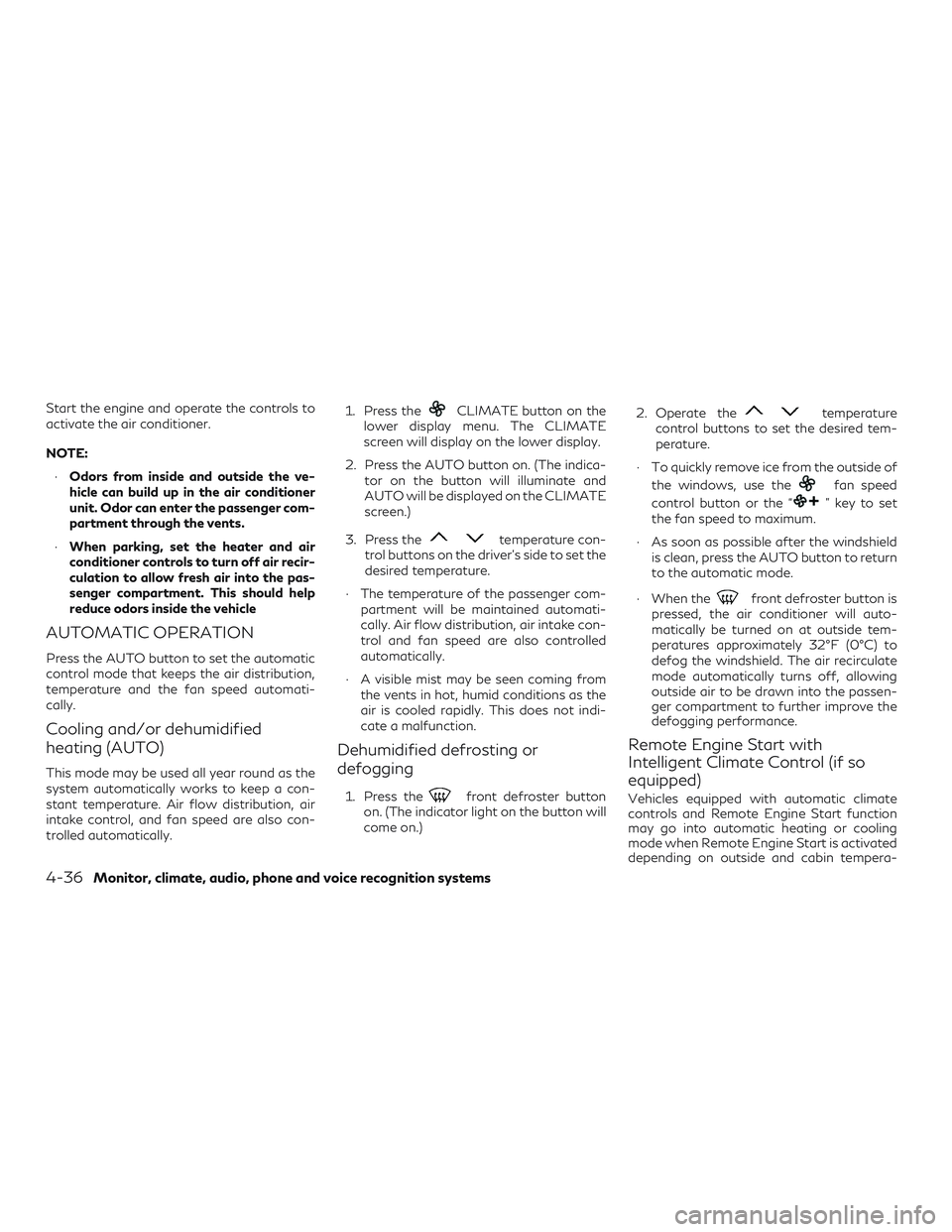
Start the engine and operate the controls to
activate the air conditioner.
NOTE:∙ Odors from inside and outside the ve-
hicle can build up in the air conditioner
unit. Odor can enter the passenger com-
partment through the vents.
∙ When parking, set the heater and air
conditioner controls to turn off air recir-
culation to allow fresh air into the pas-
senger compartment. This should help
reduce odors inside the vehicle
AUTOMATIC OPERATION
Press the AUTO button to set the automatic
control mode that keeps the air distribution,
temperature and the fan speed automati-
cally.
Cooling and/or dehumidified
heating (AUTO)
This mode may be used all year round as the
system automatically works to keep a con-
stant temperature. Air flow distribution, air
intake control, and fan speed are also con-
trolled automatically. 1. Press the
CLIMATE button on the
lower display menu. The CLIMATE
screen will display on the lower display.
2. Press the AUTO button on. (The indica- tor on the button will illuminate and
AUTO will be displayed on the CLIMATE
screen.)
3. Press the
temperature con-
trol buttons on the driver’s side to set the
desired temperature.
∙ The temperature of the passenger com- partment will be maintained automati-
cally. Air flow distribution, air intake con-
trol and fan speed are also controlled
automatically.
∙ A visible mist may be seen coming from the vents in hot, humid conditions as the
air is cooled rapidly. This does not indi-
cate a malfunction.
Dehumidified defrosting or
defogging
1. Press thefront defroster button
on. (The indicator light on the button will
come on.) 2. Operate the
temperature
control buttons to set the desired tem-
perature.
∙ To quickly remove ice from the outside of the windows, use the
fan speed
control button or the “
” key to set
the fan speed to maximum.
∙ As soon as possible after the windshield is clean, press the AUTO button to return
to the automatic mode.
∙ When the
front defroster button is
pressed, the air conditioner will auto-
matically be turned on at outside tem-
peratures approximately 32°F (0°C) to
defog the windshield. The air recirculate
mode automatically turns off, allowing
outside air to be drawn into the passen-
ger compartment to further improve the
defogging performance.
Remote Engine Start with
Intelligent Climate Control (if so
equipped)
Vehicles equipped with automatic climate
controls and Remote Engine Start function
may go into automatic heating or cooling
mode when Remote Engine Start is activated
depending on outside and cabin tempera-
4-36Monitor, climate, audio, phone and voice recognition systems
Page 247 of 572
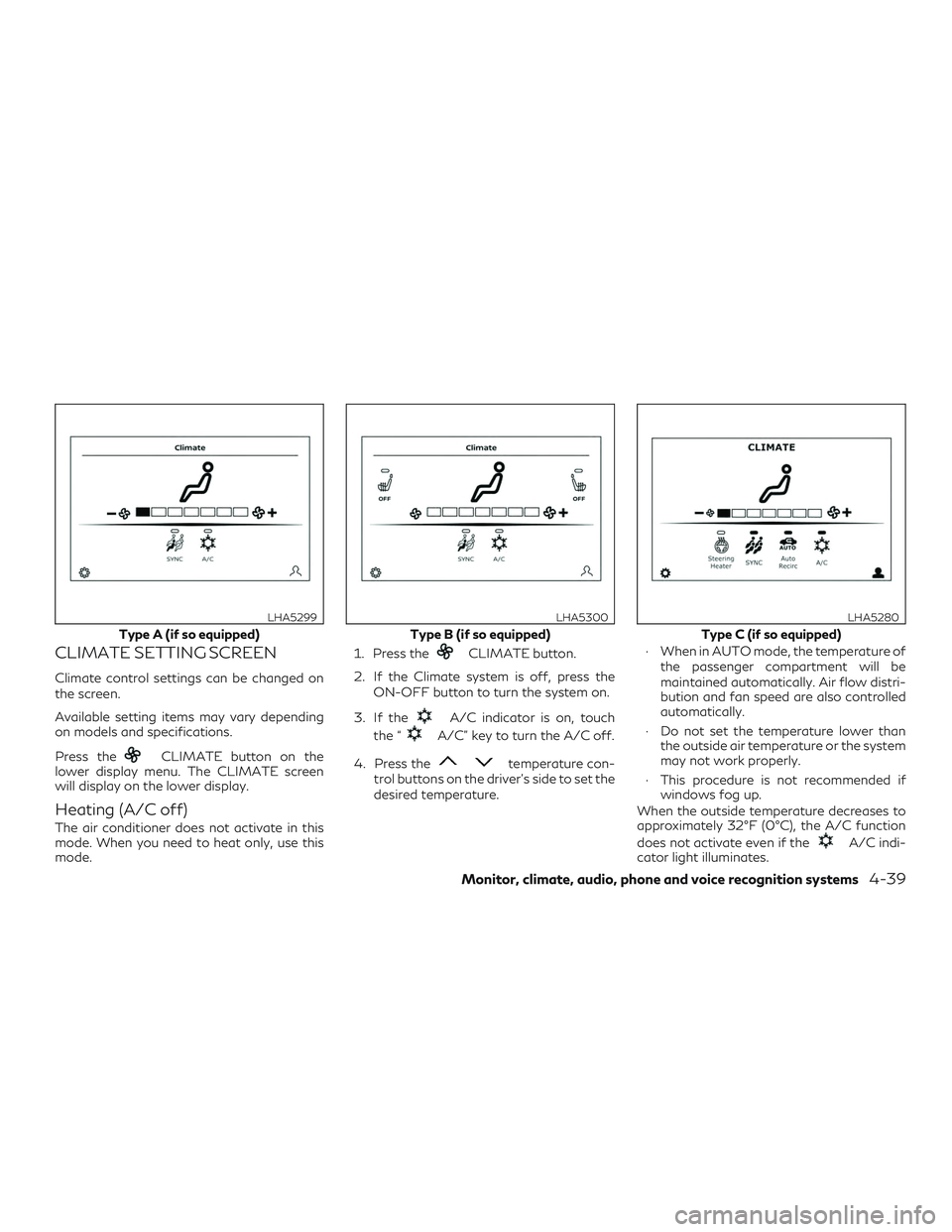
CLIMATE SETTING SCREEN
Climate control settings can be changed on
the screen.
Available setting items may vary depending
on models and specifications.
Press the
CLIMATE button on the
lower display menu. The CLIMATE screen
will display on the lower display.
Heating (A/C off)
The air conditioner does not activate in this
mode. When you need to heat only, use this
mode. 1. Press the
CLIMATE button.
2. If the Climate system is off, press the ON-OFF button to turn the system on.
3. If the
A/C indicator is on, touch
the “
A/C” key to turn the A/C off.
4. Press the
temperature con-
trol buttons on the driver’s side to set the
desired temperature. ∙ When in AUTO mode, the temperature of
the passenger compartment will be
maintained automatically. Air flow distri-
bution and fan speed are also controlled
automatically.
∙ Do not set the temperature lower than the outside air temperature or the system
may not work properly.
∙ This procedure is not recommended if windows fog up.
When the outside temperature decreases to
approximately 32°F (0°C), the A/C function
does not activate even if the
A/C indi-
cator light illuminates.
Type A (if so equipped)
LHA5299
Type B (if so equipped)
LHA5300
Type C (if so equipped)
LHA5280
Monitor, climate, audio, phone and voice recognition systems4-39
Page 292 of 572
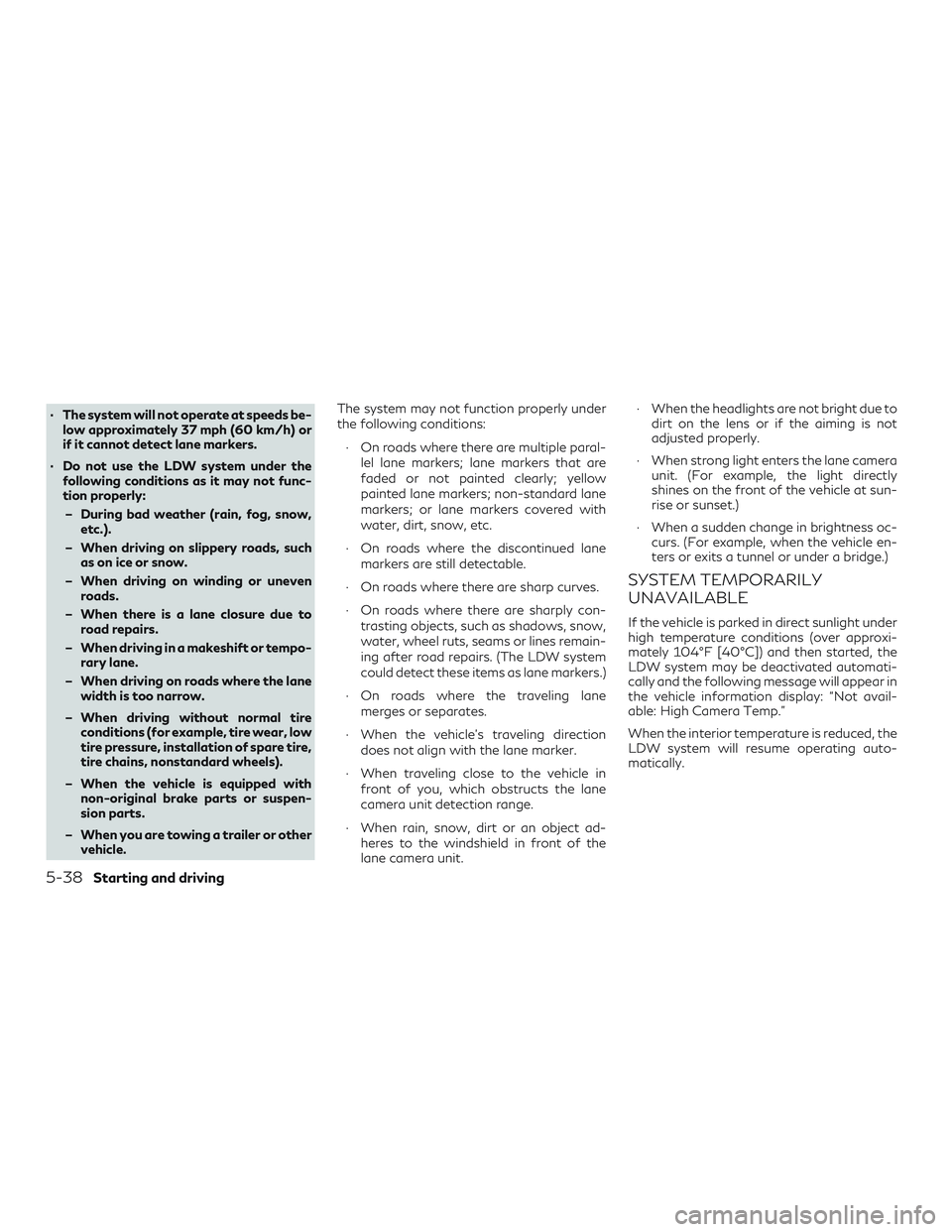
∙ The system will not operate at speeds be-low approximately 37 mph (60 km/h) or
if it cannot detect lane markers.
∙ Do not use the LDW system under the following conditions as it may not func-
tion properly:
– During bad weather (rain, fog, snow, etc.).
– When driving on slippery roads, such as on ice or snow.
– When driving on winding or uneven roads.
– When there is a lane closure due to road repairs.
– When driving in a makeshift or tempo- rary lane.
– When driving on roads where the lane width is too narrow.
– When driving without normal tire conditions (for example, tire wear, low
tire pressure, installation of spare tire,
tire chains, nonstandard wheels).
– When the vehicle is equipped with non-original brake parts or suspen-
sion parts.
– When you are towing a trailer or other vehicle. The system may not function properly under
the following conditions:
∙ On roads where there are multiple paral- lel lane markers; lane markers that are
faded or not painted clearly; yellow
painted lane markers; non-standard lane
markers; or lane markers covered with
water, dirt, snow, etc.
∙ On roads where the discontinued lane markers are still detectable.
∙ On roads where there are sharp curves.
∙ On roads where there are sharply con- trasting objects, such as shadows, snow,
water, wheel ruts, seams or lines remain-
ing after road repairs. (The LDW system
could detect these items as lane markers.)
∙ On roads where the traveling lane merges or separates.
∙ When the vehicle’s traveling direction does not align with the lane marker.
∙ When traveling close to the vehicle in front of you, which obstructs the lane
camera unit detection range.
∙ When rain, snow, dirt or an object ad- heres to the windshield in front of the
lane camera unit. ∙ When the headlights are not bright due to
dirt on the lens or if the aiming is not
adjusted properly.
∙ When strong light enters the lane camera unit. (For example, the light directly
shines on the front of the vehicle at sun-
rise or sunset.)
∙ When a sudden change in brightness oc- curs. (For example, when the vehicle en-
ters or exits a tunnel or under a bridge.)
SYSTEM TEMPORARILY
UNAVAILABLE
If the vehicle is parked in direct sunlight under
high temperature conditions (over approxi-
mately 104°F [40°C]) and then started, the
LDW system may be deactivated automati-
cally and the following message will appear in
the vehicle information display: “Not avail-
able: High Camera Temp.”
When the interior temperature is reduced, the
LDW system will resume operating auto-
matically.
5-38Starting and driving
Page 297 of 572
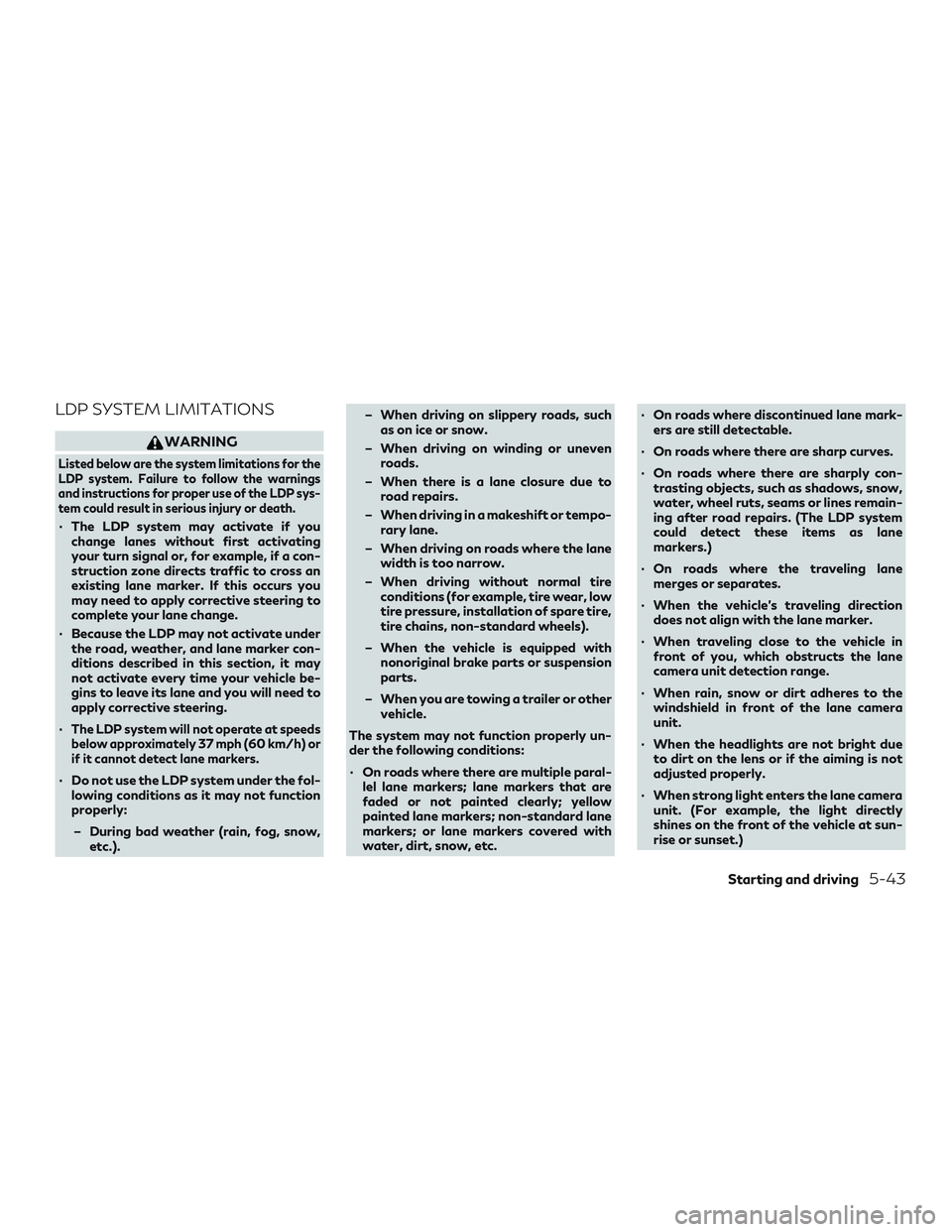
LDP SYSTEM LIMITATIONS
WARNING
Listed below are the system limitations for the
LDP system. Failure to follow the warnings
and instructions for proper use of the LDP sys-
tem could result in serious injury or death.
∙ The LDP system may activate if youchange lanes without first activating
your turn signal or, for example, if a con-
struction zone directs traffic to cross an
existing lane marker. If this occurs you
may need to apply corrective steering to
complete your lane change.
∙ Because the LDP may not activate under the road, weather, and lane marker con-
ditions described in this section, it may
not activate every time your vehicle be-
gins to leave its lane and you will need to
apply corrective steering.
∙
The LDP system will not operate at speeds
below approximately 37 mph (60 km/h) or
if it cannot detect lane markers.
∙ Do not use the LDP system under the fol- lowing conditions as it may not function
properly:
– During bad weather (rain, fog, snow, etc.). – When driving on slippery roads, such
as on ice or snow.
– When driving on winding or uneven roads.
– When there is a lane closure due to road repairs.
– When driving in a makeshift or tempo- rary lane.
– When driving on roads where the lane width is too narrow.
– When driving without normal tire conditions (for example, tire wear, low
tire pressure, installation of spare tire,
tire chains, non-standard wheels).
– When the vehicle is equipped with nonoriginal brake parts or suspension
parts.
– When you are towing a trailer or other vehicle.
The system may not function properly un-
der the following conditions:
∙ On roads where there are multiple paral- lel lane markers; lane markers that are
faded or not painted clearly; yellow
painted lane markers; non-standard lane
markers; or lane markers covered with
water, dirt, snow, etc. ∙ On roads where discontinued lane mark-
ers are still detectable.
∙ On roads where there are sharp curves.
∙ On roads where there are sharply con- trasting objects, such as shadows, snow,
water, wheel ruts, seams or lines remain-
ing after road repairs. (The LDP system
could detect these items as lane
markers.)
∙ On roads where the traveling lane merges or separates.
∙ When the vehicle’s traveling direction does not align with the lane marker.
∙ When traveling close to the vehicle in front of you, which obstructs the lane
camera unit detection range.
∙ When rain, snow or dirt adheres to the windshield in front of the lane camera
unit.
∙ When the headlights are not bright due to dirt on the lens or if the aiming is not
adjusted properly.
∙ When strong light enters the lane camera unit. (For example, the light directly
shines on the front of the vehicle at sun-
rise or sunset.)
Starting and driving5-43
Page 314 of 572
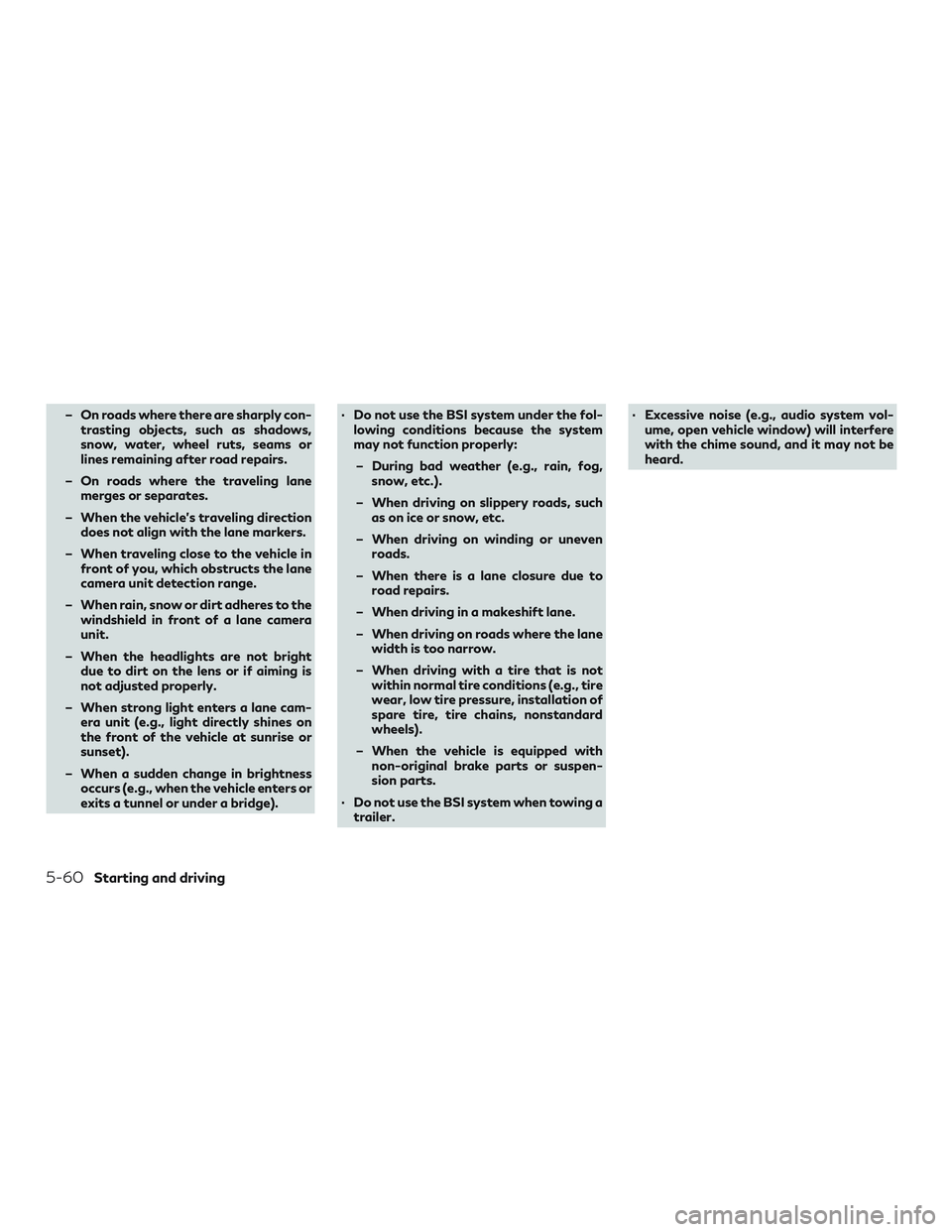
– On roads where there are sharply con-trasting objects, such as shadows,
snow, water, wheel ruts, seams or
lines remaining after road repairs.
– On roads where the traveling lane merges or separates.
– When the vehicle’s traveling direction does not align with the lane markers.
– When traveling close to the vehicle in front of you, which obstructs the lane
camera unit detection range.
– When rain, snow or dirt adheres to the windshield in front of a lane camera
unit.
– When the headlights are not bright due to dirt on the lens or if aiming is
not adjusted properly.
– When strong light enters a lane cam- era unit (e.g., light directly shines on
the front of the vehicle at sunrise or
sunset).
– When a sudden change in brightness occurs (e.g., when the vehicle enters or
exits a tunnel or under a bridge). ∙ Do not use the BSI system under the fol-
lowing conditions because the system
may not function properly:
– During bad weather (e.g., rain, fog, snow, etc.).
– When driving on slippery roads, such as on ice or snow, etc.
– When driving on winding or uneven roads.
– When there is a lane closure due to road repairs.
– When driving in a makeshift lane.
– When driving on roads where the lane width is too narrow.
– When driving with a tire that is not within normal tire conditions (e.g., tire
wear, low tire pressure, installation of
spare tire, tire chains, nonstandard
wheels).
– When the vehicle is equipped with non-original brake parts or suspen-
sion parts.
∙ Do not use the BSI system when towing a trailer. ∙ Excessive noise (e.g., audio system vol-
ume, open vehicle window) will interfere
with the chime sound, and it may not be
heard.
5-60Starting and driving
Page 321 of 572

∙The radar sensors may be blocked by tem-
porary ambient conditions such as splashing
water, mist or fog. The blocked condition
may also be caused by objects such as ice,
frost or dirt obstructing the radar sensors.
Check for and remove objects obstructing
the area around the radar sensors.
∙ Do not attach stickers (including trans-parent material), install accessories or
apply additional paint near the camera
unit or radar sensors.
∙ Do not place reflective materials, such as white paper or a mirror, on the instrument
panel. The reflection of sunlight may ad-
versely affect the camera unit’s capability
of detecting the lane markers.
∙ Do not strike or damage the area around the radar sensors. Do not touch the cam-
era lens or remove the screw located on
the camera unit. It is recommended that
you visit an INFINITI retailer if the camera
unit and/or area around the radar sen-
sors is damaged due to a collision.
Radio frequency statement
For USA
FCC: OAYSRR3B
This device complies with part 15 of the FCC
Rules. Operation is subject to the following two
conditions: (1) This device may not cause
harmful interference, and (2) this device must
accept any interference received, including
interference that may cause undesired op-
eration.
FCC Warning
Changes or modifications not expressly ap-
proved by the party responsible for compli-
ance could void the user’s authority to oper-
ate the equipment.
For Canada
Applicable law: Canada 310
This device complies with industry Canada
licence-exempt RSS standard(s).
Operation is subject to the following two
conditions: (1) This device may not cause
harmful interference, and (2) this device must
accept any interference received, including
interference that may cause undesired op-
eration of the device.
Frequency bands: 24.05–24.25GHz
Output power: less than 20 milliwatts
WARNING
Failure to follow the warnings and instruc-
tions for proper use of the RCTA system
could result in serious injury or death.
∙ The RCTA system is not a replacement
for proper driving procedures and is not
designed to prevent contact with ve-
hicles or objects. When backing out of a
parking space, always use the side and
rear mirrors and turn and look in the di-
rection your vehicle will move. Never rely
solely on the RCTA system.
The RCTA system will assist you when back-
ing out from a parking space. When the ve-
hicle is in reverse, the system is designed to
detect other vehicles approaching from the
right or left of the vehicle. If the system de-
tects cross traffic, it will alert you.
REAR CROSS TRAFFIC ALERT
(RCTA)
Starting and driving5-67
Page 343 of 572
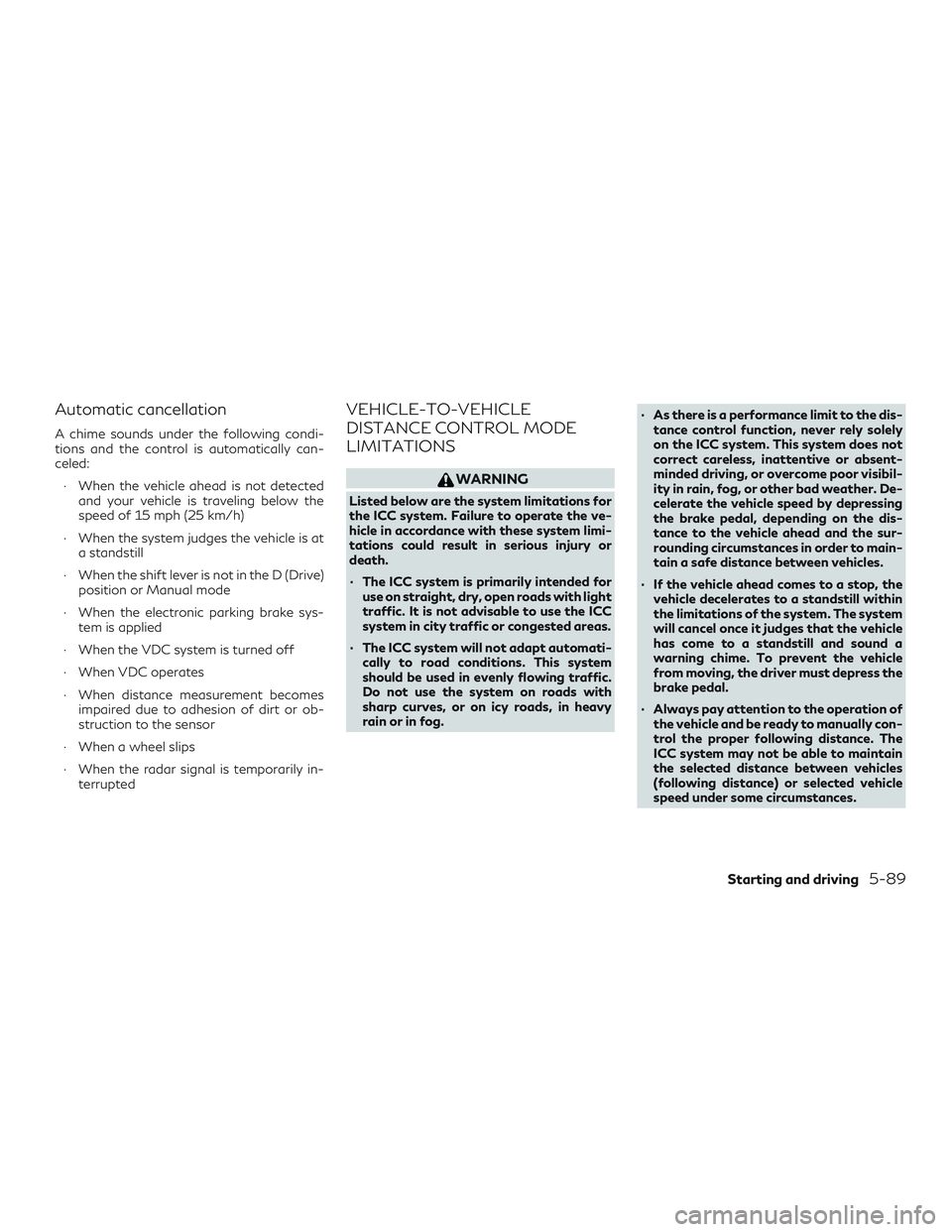
Automatic cancellation
A chime sounds under the following condi-
tions and the control is automatically can-
celed:∙ When the vehicle ahead is not detected and your vehicle is traveling below the
speed of 15 mph (25 km/h)
∙ When the system judges the vehicle is at a standstill
∙ When the shift lever is not in the D (Drive) position or Manual mode
∙ When the electronic parking brake sys- tem is applied
∙ When the VDC system is turned off
∙ When VDC operates
∙ When distance measurement becomes impaired due to adhesion of dirt or ob-
struction to the sensor
∙ When a wheel slips
∙ When the radar signal is temporarily in- terrupted
VEHICLE-TO-VEHICLE
DISTANCE CONTROL MODE
LIMITATIONS
WARNING
Listed below are the system limitations for
the ICC system. Failure to operate the ve-
hicle in accordance with these system limi-
tations could result in serious injury or
death.
∙ The ICC system is primarily intended foruse on straight, dry, open roads with light
traffic. It is not advisable to use the ICC
system in city traffic or congested areas.
∙ The ICC system will not adapt automati- cally to road conditions. This system
should be used in evenly flowing traffic.
Do not use the system on roads with
sharp curves, or on icy roads, in heavy
rain or in fog. ∙ As there is a performance limit to the dis-
tance control function, never rely solely
on the ICC system. This system does not
correct careless, inattentive or absent-
minded driving, or overcome poor visibil-
ity in rain, fog, or other bad weather. De-
celerate the vehicle speed by depressing
the brake pedal, depending on the dis-
tance to the vehicle ahead and the sur-
rounding circumstances in order to main-
tain a safe distance between vehicles.
∙ If the vehicle ahead comes to a stop, the vehicle decelerates to a standstill within
the limitations of the system. The system
will cancel once it judges that the vehicle
has come to a standstill and sound a
warning chime. To prevent the vehicle
from moving, the driver must depress the
brake pedal.
∙ Always pay attention to the operation of the vehicle and be ready to manually con-
trol the proper following distance. The
ICC system may not be able to maintain
the selected distance between vehicles
(following distance) or selected vehicle
speed under some circumstances.
Starting and driving5-89
Page 371 of 572
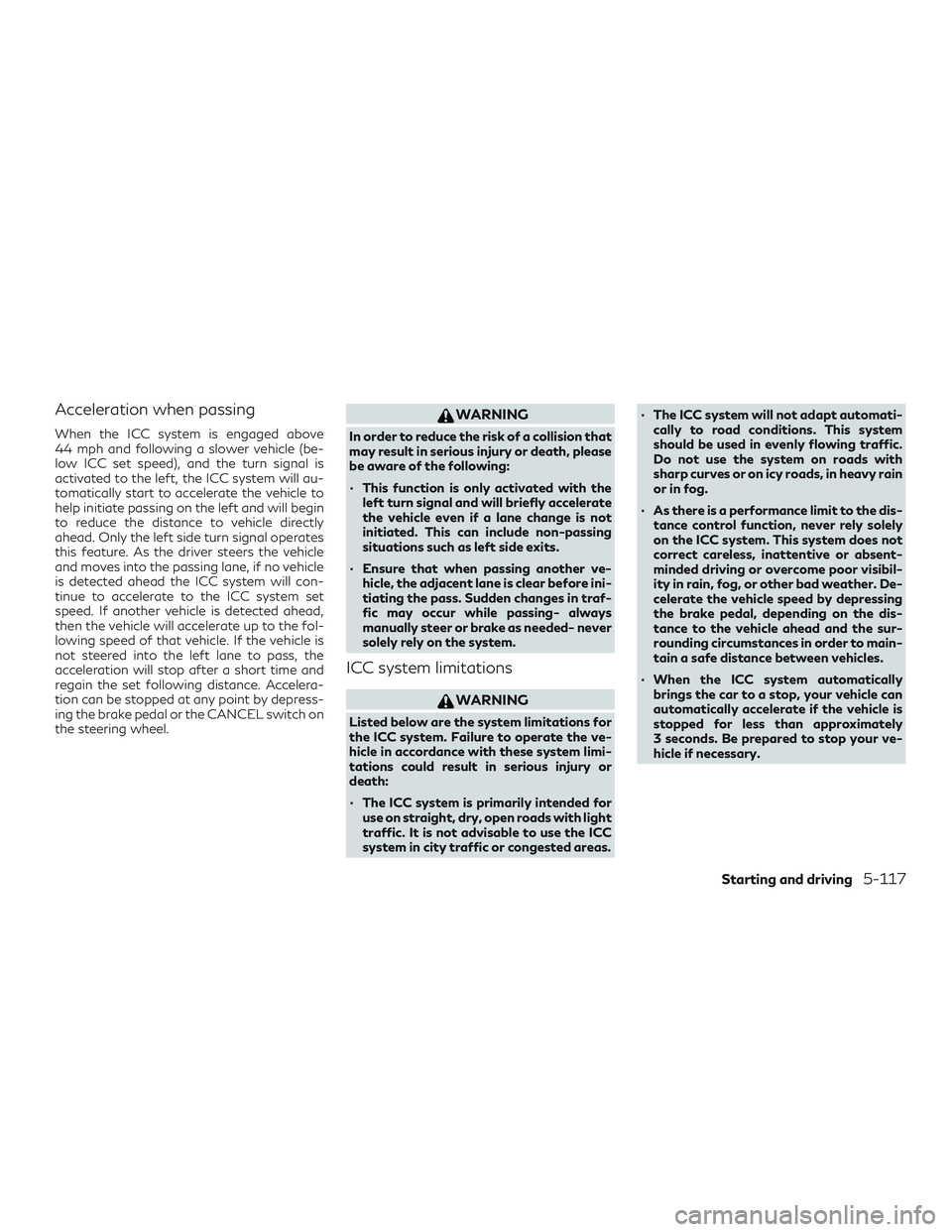
Acceleration when passing
When the ICC system is engaged above
44 mph and following a slower vehicle (be-
low ICC set speed), and the turn signal is
activated to the left, the ICC system will au-
tomatically start to accelerate the vehicle to
help initiate passing on the left and will begin
to reduce the distance to vehicle directly
ahead. Only the left side turn signal operates
this feature. As the driver steers the vehicle
and moves into the passing lane, if no vehicle
is detected ahead the ICC system will con-
tinue to accelerate to the ICC system set
speed. If another vehicle is detected ahead,
then the vehicle will accelerate up to the fol-
lowing speed of that vehicle. If the vehicle is
not steered into the left lane to pass, the
acceleration will stop after a short time and
regain the set following distance. Accelera-
tion can be stopped at any point by depress-
ing the brake pedal or the CANCEL switch on
the steering wheel.
WARNING
In order to reduce the risk of a collision that
may result in serious injury or death, please
be aware of the following:
∙ This function is only activated with theleft turn signal and will briefly accelerate
the vehicle even if a lane change is not
initiated. This can include non-passing
situations such as left side exits.
∙ Ensure that when passing another ve- hicle, the adjacent lane is clear before ini-
tiating the pass. Sudden changes in traf-
fic may occur while passing- always
manually steer or brake as needed- never
solely rely on the system.
ICC system limitations
WARNING
Listed below are the system limitations for
the ICC system. Failure to operate the ve-
hicle in accordance with these system limi-
tations could result in serious injury or
death:
∙ The ICC system is primarily intended foruse on straight, dry, open roads with light
traffic. It is not advisable to use the ICC
system in city traffic or congested areas. ∙ The ICC system will not adapt automati-
cally to road conditions. This system
should be used in evenly flowing traffic.
Do not use the system on roads with
sharp curves or on icy roads, in heavy rain
or in fog.
∙ As there is a performance limit to the dis- tance control function, never rely solely
on the ICC system. This system does not
correct careless, inattentive or absent-
minded driving or overcome poor visibil-
ity in rain, fog, or other bad weather. De-
celerate the vehicle speed by depressing
the brake pedal, depending on the dis-
tance to the vehicle ahead and the sur-
rounding circumstances in order to main-
tain a safe distance between vehicles.
∙ When the ICC system automatically brings the car to a stop, your vehicle can
automatically accelerate if the vehicle is
stopped for less than approximately
3 seconds. Be prepared to stop your ve-
hicle if necessary.
Starting and driving5-117
Page 373 of 572

The detection zone of the radar sensor is
limited. A vehicle ahead must be in the detec-
tion zone for the ICC system to maintain the
selected distance from the vehicle ahead. A
vehicle ahead may move outside of the de-
tection zone due to its position within the
same lane of travel. Motorcycles may not be
detected in the same lane ahead if they are
traveling offset from the center line of the
lane. A vehicle that is entering the lane ahead
may not be detected until the vehicle has
completely moved into the lane.
If this occurs, the ICC system may warn you
by blinking the system indicator and sounding
the chime. The driver may have to manually
control the proper distance away from the
vehicle traveling ahead.
The ICC system (with ProPILOT Assist) uses
a multi-sensing front camera. The following
are some conditions in which the camera may
not properly detect a vehicle and detection of
a vehicle ahead may be delayed:∙ Poor visibility (conditions such as rain, snow, fog, dust storms, sandstorms, and
road spray from other vehicles)
∙ The camera area of the windshield is fogged up or covered with dirt, water
drops, ice, snow, etc. ∙ Strong light (for example, sunlight or high
beams from oncoming vehicles) enters
the front camera
∙ A sudden change in brightness occurs (for example, when the vehicle enters or
exits a tunnel or shaded area or lightning
flashes)
Starting and driving5-119
Page 381 of 572

WARNING
Steering Assist is not a system for a hands-
free driving. Always keep your hands on the
steering wheel and drive your vehicle
safely. Failure to do so could cause a colli-
sion resulting in serious personal injury or
death.
NOTE:
If the driver lightly touches (instead of firmly
grips) the steering wheel, the steering
torque sensor may not detect the driver’s
hand(s) on the steering wheel and a sequence
of warnings may occur. When the driver
holds and operates the steering wheel again,
the warnings turn off.
Steering Assist limitations
WARNING
∙ In the following situations, the camera may not detect lane markers correctly or
may detect lane markers incorrectly and
the Steering Assist may not operate
properly: – When driving on roads where there
are multiple parallel lane markers, lane
markers that are faded or not painted
clearly, nonstandard lane markers, or
lane markers covered with water, dirt,
snow, etc.
– When driving on roads with discontin- ued lane markers
– When driving on roads with a widen- ing or narrowing lane width
– When driving on roads where there are multiple lanes or unclear lane
markers due to road construction
– When driving on roads where there are sharply contrasting objects, such
as shadows, snow, water, wheel ruts,
seams, or lines remaining after road
repairs (the Steering Assist could de-
tect these items as lane markers)
– When driving on roads where the traveling lane merges or separates
∙ Do not use the Steering Assist under the following conditions because the system
may not properly detect lane markers.
Doing so could cause a loss of vehicle con-
trol and result in an accident. – During bad weather (rain, fog, snow,
dust, etc.)
– When rain, snow, sand, etc., is thrown up by the wheels of other vehicles
– When dirt, oil, ice, snow, water, or an- other object adheres to the camera
unit
– When the lens of the camera unit is foggy
– When strong light (for example, sun- light or high beams from oncoming ve-
hicles) shines on the camera
– When the headlights are not bright due to dirt on the lens or the head-
lights are off in tunnels or darkness
– When a sudden change in brightness occurs (for example, when the vehicle
enters or exits a tunnel or is under a
bridge)
– When driving on roads where the traveling lane merges or separates or
where there are temporary lane mark-
ers because of road construction
– When there is a lane closure due to road repairs
Starting and driving5-127